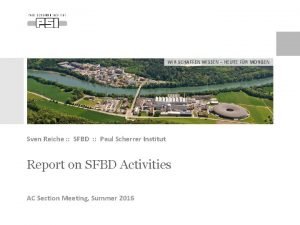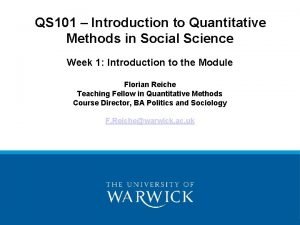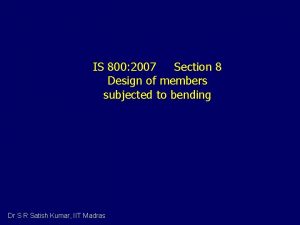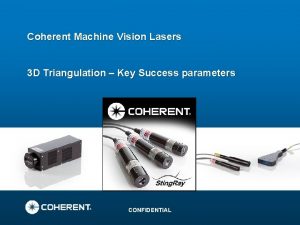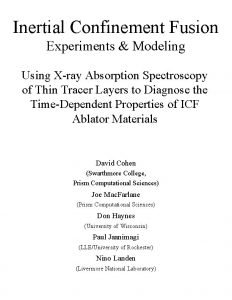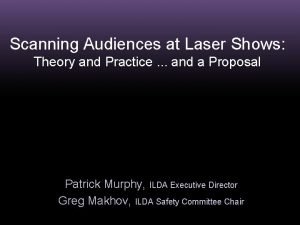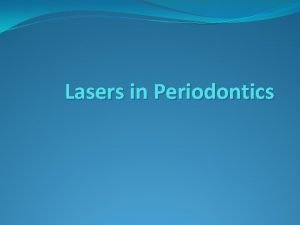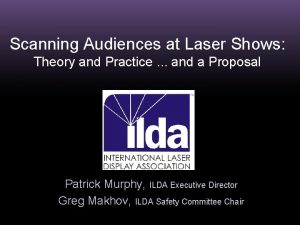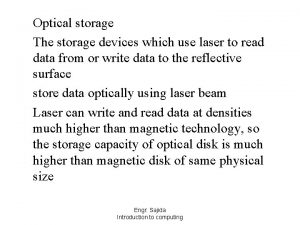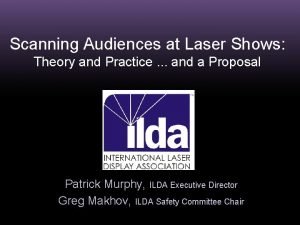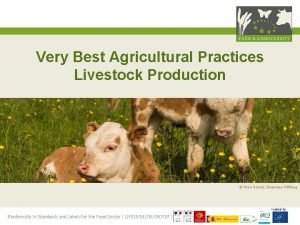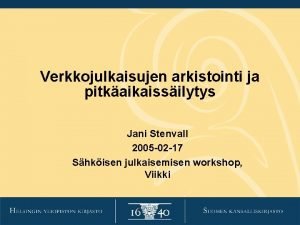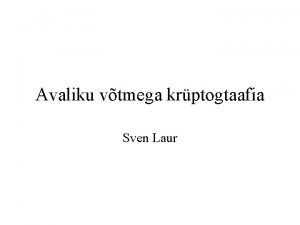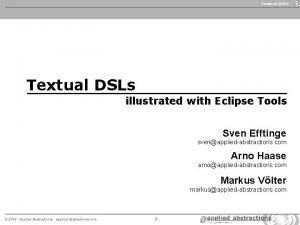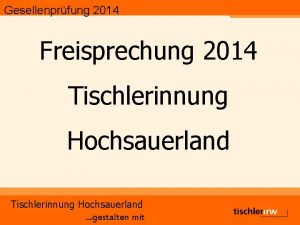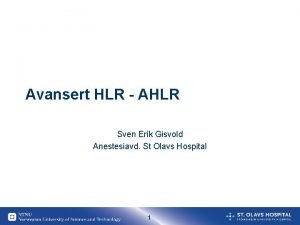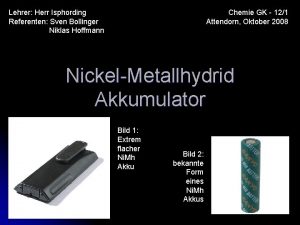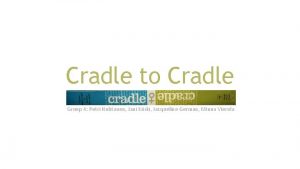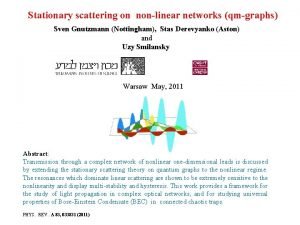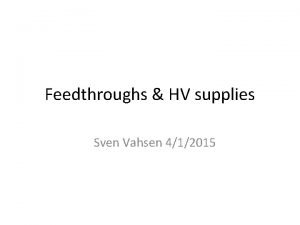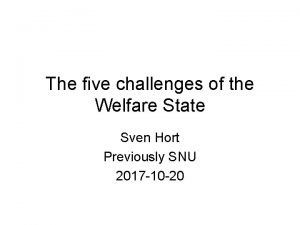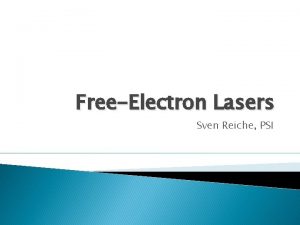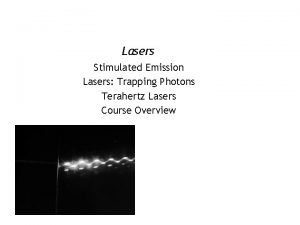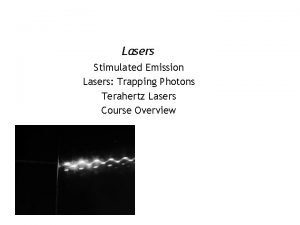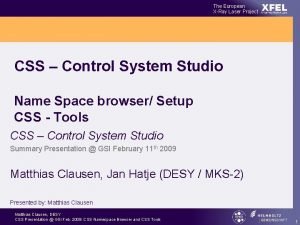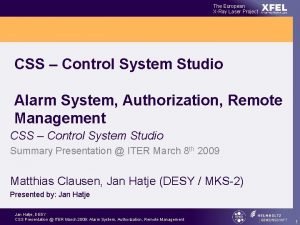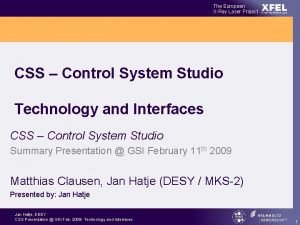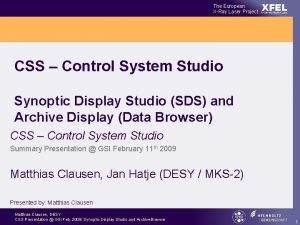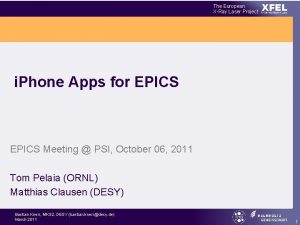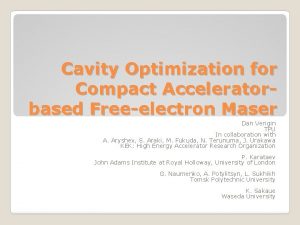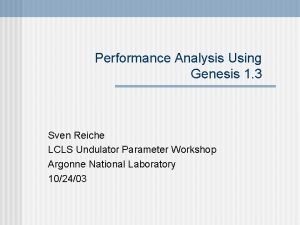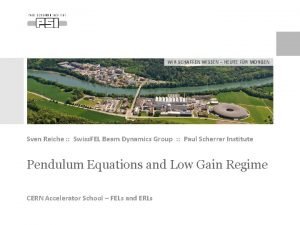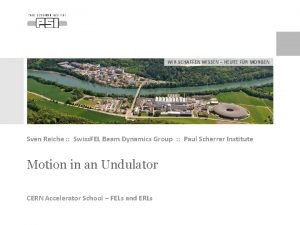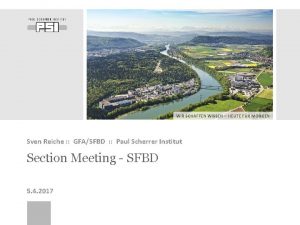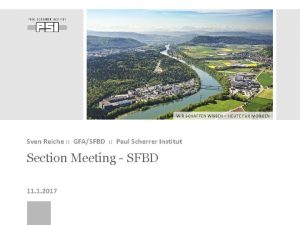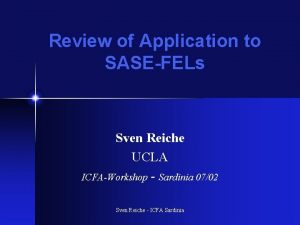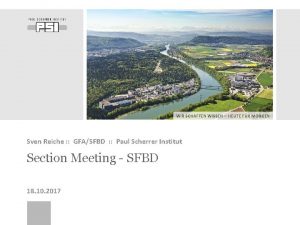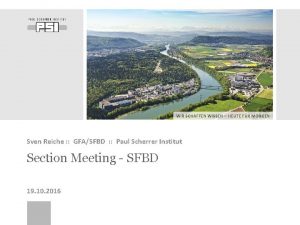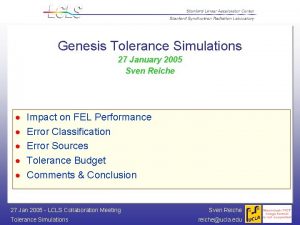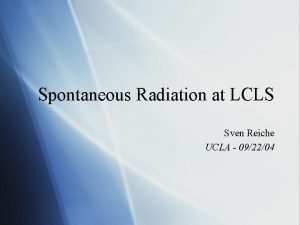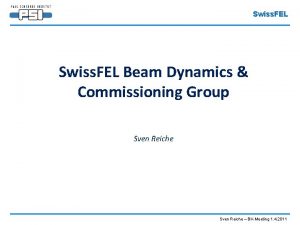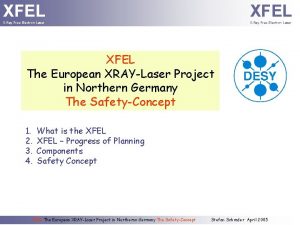Optimization of Compact Xray Freeelectron Lasers Sven Reiche























- Slides: 23

Optimization of Compact X-ray Free-electron Lasers Sven Reiche May 27 th 2011

Free-Electron Lasers

Electron Beam Parameters Almost everything scales with the FEL parameter (1 D Model): The characteristic length is the power gain length: (Ideal Case) Increasing the current and/or reducing the emittances increase the performance and reduce the overall required length of the FEL. Impact of energy spread and emittance needs to be small (Both spreads out any bunching and thus act against FEL process):

Saturation Power and Brilliance Saturation power: For a given wavelength it favors a higher beam energy and thus a longer undulator period. Peak Brilliance: Swiss. FEL At saturation: (transverse coherence)

Optimizing the Focusing Decreasing the b-function (increase focusing), increases the FEL parameter r. Too strong focusing enhances the emittance effect and increasing the FEL gain length. From 1 D Theory: 3 D Optimization for Swiss. FEL

Transverse Coherence (2 D FEL Theory) Diffraction Parameter: Rayleigh Length Char. Scaling of FEL (=2 kur in 1 D model) Assuming electron size as radiation source size: Electron Constraint for emittance to be smaller than photon emittance for all electrons to contribute on the emission process Photon Emittance px x Diffraction Limited Photon Emittance

Transverse Coherence (Saldin et al) Growth rates for FEL eigenmodes (r, f-decomposition): Optimum growth rate of 1 D model Optimum: Note: fundmental FEL Eigenmode has intrinsic wavefront curvarture and thus correspond to a larger photon emittance Increased gain length due to strong diffraction Mode competition and reduced coherence

Additional Effects Growth of transverse coherence = spreading the phase information transversely. Spreading Convection Diffraction Phase spread by field FEL Theory only treats diffraction effects, but spreading is dominating effect in short wavelength FELs Emittance constraints is relaxed when realistic electron motion is included Beam size variation Phase spread by electrons TEM 01 Growth rate Rigid FODO Lattice 8

Definition of Coherence (Goodman) Coherence is a stochastic quantity and correlates the phase relation between two transverse location: Mutual Coherence Function Normalized Coherence Factor In relation to diffraction experiments: A pulse can be fully coherent without 100% contrast in interference pattern (E 0(r 1) ≠E 0(r 2)). The quasi-monochromatic approximation (E 0(t)=E 0(t+dt)) is not necessarily fulfilled. Single spike pulse is not a stationary process and would require ensemble average. E 0(r 1, t) E 0(r 2, t-dt) E 0(r 2, t)

Example: Coherence for Swiss. FEL Intensity en = 0. 43 mm mrad Spot Size: 0. 0018 mm 2 Coherence Area: 0. 021 mm 2 Intensity en = 0. 86 mm mrad Spot Size: 0. 0023 mm 2 Coherence Area: 0. 015 mm 2 Mutual Coherence z=0. 69 z=0. 86 10

Towards Compact FELs Approach A Approach B Reduce undulator period by Maximize the FEL parameter by using a laser wiggler as radiation device. maximizing the peak current. Provide a low emittance, low energy spread beam. Moderate peak current which are consistent with the low emittance and energy spread values. Field Emitter Source Large FEL parameters allows for relaxed values for energy spread and emittance. “Conventional” undulator design though with a short undulator period. Plasma Injector

Case Study: Laser Wiggler

From XFEL to Laser Wiggler Resonance Condition lu: 5 cm 500 nm g: 15 Ge. V 20 Me. V FEL Parameter r: 5. 10 -4 5. 10 -5 Due to the scaling, the FEL parameter is always smaller for laser wiggler than for conventional SASE FELs. In addition, the extreme constraints on the beam quality limits the current to a much smaller value than for SASE FELs.

Case Study for Laser Wiggler Energy 6. 5 Me. V Current 500 A Energy Spread 60 e. V (!!!) Emittance 0. 1 mm mrad (!) Laser Period 500 nm Laser Field Strength 0. 5 FEL Wavelength 2 nm Emittance and spread has been artificially chosen to allow the FEL to laser with the given peak current. Energy spread is way beyond state-of-the-art electron beam sources. Electron emittance much larger than photon emittance.

Coherence Properties An estimate of the coherence can be obtained by the fluctuation in the radiation power. As expected from the high beam emittance value, only a poor degree of coherence is achieved. Pulse profile at saturation Less than 10% coherence

Comments on the Laser Field Bunch Waist size Incident Laser Interaction Length Field stability requirement for all electrons along the interaction length: Most stringent requirement for transverse dimension over at least 2 s of the bunch, assuming a fundamental Gauss mode (alternative is transverse mode stacking): Required radiation power: For the example given the required power is 0. 5 PW with a pulse duration of 15 ps !!!!

Case Study: High Current Electron Beam and Short Period Undulator

Basic Strategy Very high peak currents yield a very large FEL parameter, which allows relaxed constraints for the electron beam quality (energy spread, emittance). The beam energy is still reasonable large (>100 Me. V) to allow for short wavelength while fulfilling the coherence condition. Possible sources are plasma injector with an ultra short drive laser to drive a non-linear trapping mechanism of electrons. Currently an active field of research (LOA, LMU, LBNL etc. )

Electron Beam Parameters Energy 0. 1 - 2 Ge. V Current 10 - 150 k. A (!) Emittance 1 mm mrad Energy spread <1% Charge 10 – 1000 p. C Ambitious beam parameters, though the lower end has been successful demonstrated at LOA. Most critical parameter is the energy spread, which requires a FEL parameter on the same order or larger. C. Rechatin et al, Phys. Rev. Lett. , 102, 164801 (2009)

Case Study Overly optimistic case (LMU Munich, courtesy of A. Maier/A. Meseck). E = 2 Ge. V s. E/E = 0. 04 % (!!!) en = 0. 5 mm mrad (!) I = 100 k. A (!) Undulator: lu = 5 mm, K = 0. 65 l= 2. 5 Å FEL parameter is ~10 -3, thus requiring good beam parameters to make the FEL work. Also coherence is reduced.

A More Reasonable Case Larger spread and emittance, less current Energy 1 Ge. V Current 10 k. A Emittance 1 mm mrad Energy spread 5 Me. V Results for l = 1 nm Effective FEL Parameter 0. 1% Gain Length 0. 23 m Saturation Length 4. 8 m Saturation Power 9 GW Bandwidth 0. 23 % FWHM

Optimization for Very High Energy Spreads Use dispersion to stretch the bunch. Reduces bunch current and energy spread Energy spread conditions improves due to the I 1/3 dependence of the FEL parameter. Helps for very large energy spreads: Current 10 k. A 1 k. A Energy Spread 20 Me. V 2 Me. V Sat. Power 1 GW 0. 4 GW Sat. Length 19 m 14 m

Summary Coherence and peak brightness favors Ge. Vs electron beams with high peak currents. Plasma injectors are promising candidates for compact x-ray FELs, though the performance seems to be feasible only down to 1 nm Laser wigglers yield only poor performance (poor coherence) even if the unrealistic beam and laser parameters could be met. Plasma Beam Laser Wiggler
 Sven reiche
Sven reiche Qiba moodle
Qiba moodle Plastic compact semi compact slender
Plastic compact semi compact slender Machine vision lasers
Machine vision lasers Inertia xray
Inertia xray Audience scanning lasers
Audience scanning lasers Gingivoplasty
Gingivoplasty Audience scanning lasers
Audience scanning lasers Properties of laser light
Properties of laser light It uses laser to read the data
It uses laser to read the data Audience scanning lasers
Audience scanning lasers Traueranzeige sven schulz greifswald
Traueranzeige sven schulz greifswald Sven jani
Sven jani Sven van laere
Sven van laere Sven laur
Sven laur Sven efftinge
Sven efftinge Sven görmann
Sven görmann Pea hjerterytme
Pea hjerterytme Niklas bollinger
Niklas bollinger Sven jani
Sven jani Sven gnutzmann
Sven gnutzmann Sven vahsen
Sven vahsen Sven hort
Sven hort Sven hauff
Sven hauff
